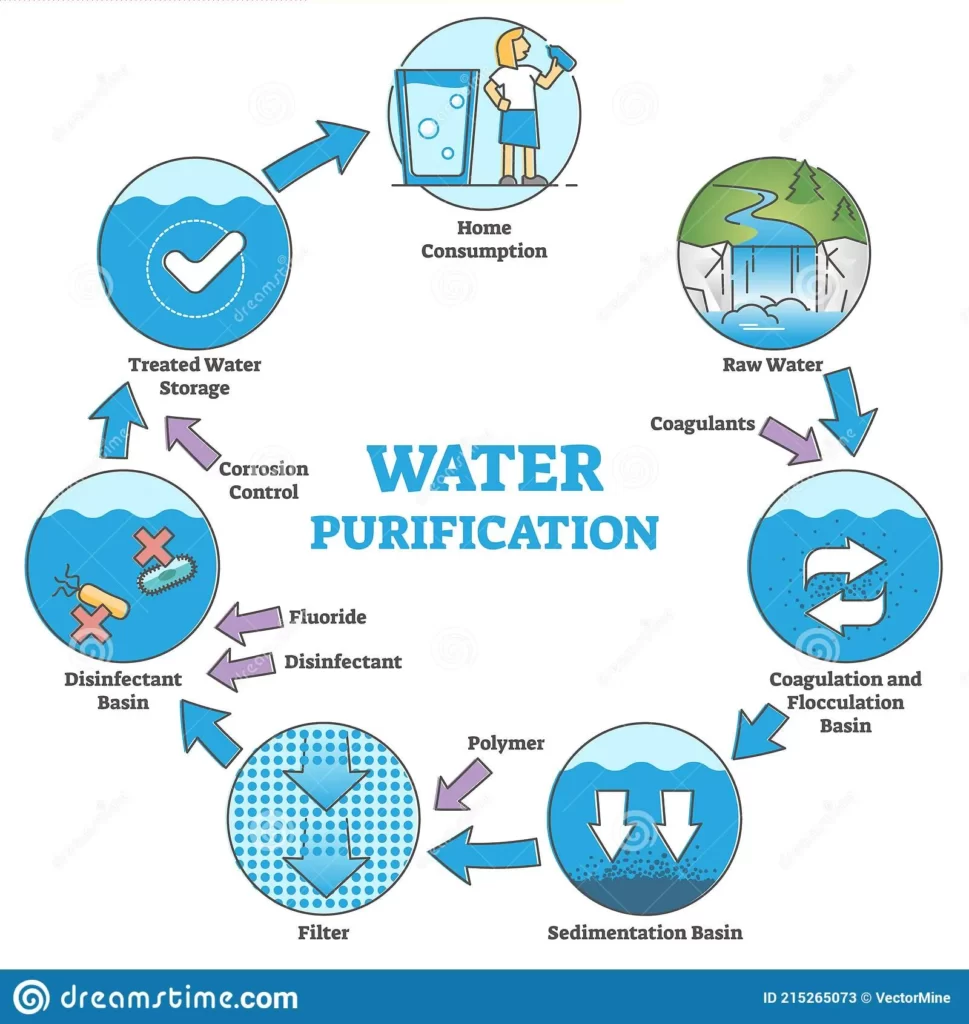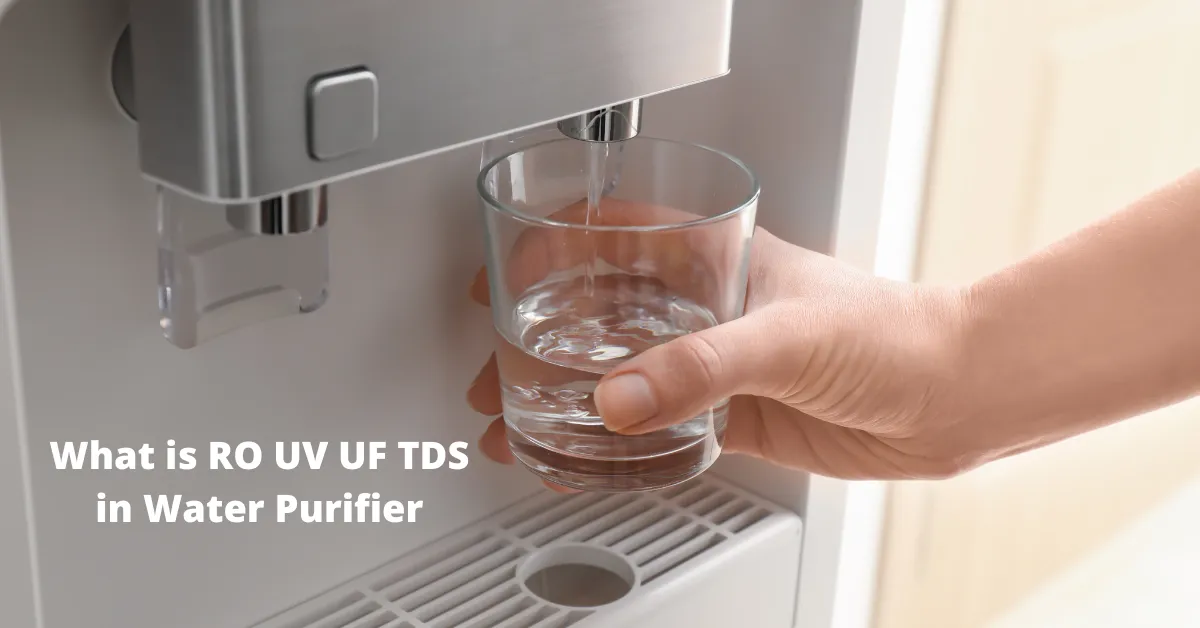RO meaning or full form is Reverse Osmosis; UV meaning or full form is Ultraviolet; UF meaning or full form is Ultra filtration and TDS meaning or full form is Total Dissolved Solids.
You have a water purifier, but you don’t know what the different filters are or which one to use.You want to drink clean, healthy water but don’t know how to make this happen. The various technologies all sound similar, but they aren’t the same.
This guide will help you understand the differences between RO, UV, UF, and TDS water filters to choose the right one for your water.
What is RO UV UF TDS in Water Purifier?
RO, UV, UF, and TDS water filters are all technologies that remove different types of contaminants from water. These filters can be used for both domestic and commercial purposes. Each type of filter has its benefits and drawbacks, so it’s essential to choose the right one for your needs.
RO water filters remove all contaminants, including bacteria, protozoa, and chemical pollutants, and UV water filters kill bacteria, protozoa, and other pathogens. UF water filters remove sediments, chlorine taste, odour, and other contaminants. TDS water filters remove lead and other heavy metals. So far, we have discussed the primary aspects of RO, UV, UF, and TDS. Now let us dive deep into each of these in detail. So read on.

RO Water Purifier Means What and Its Functions
RO Full form in water purifier is “Reverse Osmosis.” It is a process that uses pressure and water to remove contaminants from a liquid. By using RO, companies can reduce the amount of waste they produce and efficiently use their water resources.
RO, or reverse osmosis, is a water purification process that removes contaminants from water by pushing it through a semipermeable membrane. This membrane allows only water molecules to pass while trapping pollutants and other particles. RO is used to purify tap and bottled water and is considered one of the most effective methods of filtering out impurities. Some of the contaminants that RO can remove include arsenic, lead, mercury, and chlorine.
UV Water Purifier Means What and Its Functions
UV full form in water purifier is “Ultraviolet”. UV is a form of energy that is emitted from the sun. UV light is also used in water purification systems. It kills bacteria and other microorganisms in the water and is a very effective way to purify water.
UV light is a type of electromagnetic radiation with a shorter wavelength than visible light. It is used in water purification to kill microorganisms, such as bacteria and viruses. UV radiation damages the genetic material of the organisms, causing them to die. UV light is also used to disinfect surfaces and air.
UV light is one of the most important factors when choosing a water purification system, and it is also a very efficient way to treat water and is relatively inexpensive.
UF Water Purifier Means What and Its Functions
UF full form in water purifier is “Ultra-Filtration”. It is a water purification technology that uses a continuous filtration process to reduce the amount of sediment, bacteria, and other contaminants in drinking water. It can also be used to treat wastewater and industrial effluent. UF systems are often installed with other water treatment technologies such as reverse osmosis or activated carbon filters.
UF is a water purification process that uses a semipermeable membrane to remove pollutants and contaminants from water. The membrane allows water to pass while trapping bacteria, viruses, and other pollutants. UF is a popular water purification method for residential and commercial applications.
This process can be used to provide clean and safe drinking water for people in places where water is not available from groundwater or surface sources.
Related Post:
Best Hot and Cold Water Purifier in India 2022: Buyer’s Guide
Best Gravity Based Water Purifier India: 2022 What To know
TDS Meaning in Water Purifier and What does it do?
TDS full form in water purifier is “total dissolved solids.” It’s a measure of the amount of solid material (in milligrams) that’s dissolved in a litre of water. High TDS levels can indicate problems with water quality, such as scaling or corrosion. TDS is also an important factor in water treatment and purification.
TDS measurement is used to determine the efficiency of a water purification system. The higher the TDS number, the more difficult it will be for contaminants to pass through the filter.
Total Dissolved Solids will be highest in soft water and lowest in hard water. Purification with a filter that removes TDS will also remove other contaminants, including bacteria, protozoa, and viruses.
Generally, water with a low TDS level is considered purer than water with a high TDS level. Water with a low TDS level is less likely to cause corrosion and scaling in pipes and other equipment, and it is also less corrosive to the skin.
How to remove TDS from drinking water at home?
Water is one of the essential elements of human life. It is necessary to drink water every day to stay healthy, but it is also vital to have clean water for cooking, cleaning, and other purposes. While most municipal water supplies are safe to drink, small amounts of contaminants in the water can cause health problems over time. One of the most common contaminants in the water is Total Dissolved Solids (TDS). TDS includes all the dissolved minerals and salts in water. While some TDS is average and can even be beneficial, too much TDS can cause health problems.
High levels of TDS can make water taste and smell bad and cause problems in appliances and fixtures. There are several ways to remove TDS from water:
1) Use a reverse osmosis system. Reverse osmosis systems use pressure to force water through a semipermeable membrane, which removes most of the dissolved solids.
2) Use an activated carbon filter. Activated carbon filters are specifically designed to remove chlorine, other chemicals, and dissolved solids.
3) Install a water softener. Water softeners use ion exchange to remove minerals like calcium and magnesium, which can increase TDS levels.
4)Ion exchange systems are also effective at removing TDS from water, but they are limited to only removing specific types of ions.
Frequently Asked Questions
What is RO UF UV TDS?
RO UF UV TDS stands for Reverse Osmosis, Ultra Filtration, and Ultraviolet Disinfection. These three technologies are often used in water treatment systems to produce high-quality drinking water. RO removes particles and contaminants from the water by forcing them through a semipermeable membrane. UF removes smaller particles and bacteria, and UV disinfects the water to kill any remaining bacteria.
Which is better, RO UV or RO UF?
There is no definitive answer to this question as it depends on various factors, such as the specific water needs of your business or household and the quality of your water source. However, in general, RO UV systems are better at removing contaminants from water than RO UF systems.
Does UV UF filter reduce TDS?
UV and UF filters do not reduce TDS. TDS is a measure of the dissolved minerals in the water, and these filters do not remove any minerals from the water.
Is UF water good for your health?
There is no perfect answer to this question, as the health benefits of drinking UF water may vary from person to person. Some people believe that UF water is healthier than traditional tap water because it has been filtered to remove impurities. In contrast, others claim that the process of UF water production can strip away beneficial minerals essential for good health. Ultimately, the best way to determine whether or not UF water is suitable for you is to try it out and see how you feel.
What is the use of TDS in water purifier?
TDS, or total dissolved solids, measures the amount of dissolved minerals in the water. A water purifier with a TDS meter can help determine whether the water you’re drinking is safe and clean. If the TDS level is high, there are a lot of dissolved minerals in the water, and drinking may not be secure.
To Sum Up
By now you have got a clear explanation about the query What is RO UV UF TDS in Water Purifier. RO, UV, UF, and TDS water filters are necessary to purify your water and ensure that you are drinking clean and safe water. If you are interested in purchasing a water filter, be sure to research to find the best one for your needs.
RO, UV, UF, and TDS water filters are all effective filtration methods. Each has unique benefits and drawbacks, so choosing the right filter for your needs is essential. If you are unsure which filter is right for you, consult a professional to help you make the best decision.
Recommended Read:
Gravity-Based Water Purifier vs RO : Which is Best for You?
What are the Advantages and Disadvantages of a Water Purifier?
